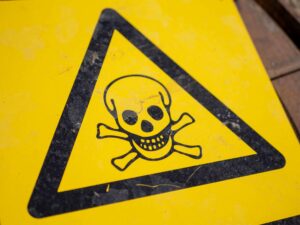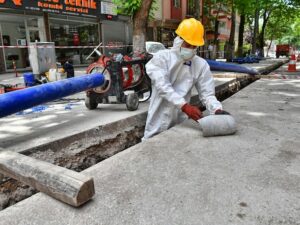
How To Identify And Treat Asbestos In The Workplace Environment
You need to know how to identify and treat asbestos in the workplace environment. A qualified person with knowledge of asbestos needs to handle the identification and risk assessment required by law. As a Department of Employment and Labour Approved Inspection Authority, we’ll teach you why asbestos identification is essential to your business operations, employee health, and compliance with the law.
What Is Asbestos?
Asbestos is a heat-resistant silicate mineral in a fibrous form.
It serves countless industries in a variety of ways. These uses primarily involve augmenting the construction process. Asbestos works in tandem with ceiling tiles, floor panels, and the like to provide, for example, insulation from the cold.
While it provided many benefits, researchers discovered that asbestos caused severe health complications.
What Are The Hazards Of Asbestos In The Workplace?
To understand the hazards of asbestos in the workplace, you must understand the symptoms of asbestosis and the unlikelihood that you will recover once it sets in.
Asbestosis is long-term scarring and inflammation of the lungs caused by asbestos fibres.
Symptoms range from coughs and shortness of breath to lung cancer and pulmonary heart disease. Breathing in many fibres, usually over years of exposure, while working with asbestos is all it takes for asbestosis to occur.
The risk of exposure is so dangerous that when someone uncovers asbestos, it is advisable to leave it rather than attempt to remove it. Asbestosis has no cure once contracted. Indirect treatments may lessen the symptoms, but they do not solve the problem.
Asbestos Maintenance And Removal Work In The Workplace
To safely handle, remove, or distribute asbestos-containing materials in the workplace, you need to have a proper control program.
The goal of your control program is to prevent or minimise the release of asbestos fibres into the air.
As an employer or safety officer, your role is to create a safe control program that workers can implement according to the Department of Employment and Labour’s regulations.
Typically, your asbestos control plan should address the following:
- Reporting procedures for suspected asbestos should be in place.
- Identify the location, type, friability (how easily it crumbles), and condition of the asbestos.
- Engineering controls, work practices, hygiene practices, and required facilities to control employees’ exposure to asbestos.
- Provide workers with task-specific work instructions that address the hazards and the necessary controls.
- Provide, and maintain appropriate personal protective equipment.
- Monitor the concentration of airborne asbestos to access the danger levels.
- Facilities and steps to decontaminate workers’ clothes, etc.
- Steps to remove and clean asbestos waste and related materials.
Critical to developing your control plan is understanding what an asbestos analysis is. With the proper understanding, you can develop a control program that employees can follow when handling asbestos in the workplace.
How To Reduce The Risk Of Asbestos At Work: 3 Smart Steps To Take
There are some steps that you can take to reduce the risk of asbestos exposure.
Train Your Workers
The most important thing is to make sure your teams are fully briefed and trained to know what to do if you uncover asbestos in your office building. Workers should know:
- How to identify asbestos materials in the workplace.
- The dangers of exposure to asbestos and its long-term effects.
- The designated disposal methods outlined by the company.
- The value of any required health monitoring.
Use Adequate PPE
Personal Protective Equipment (PPE) is another crucial factor in workplace safety. Specific rules are paramount:
- PPE must be properly fixed to the wearer.
- Respirators must be on-hand for any workers working near asbestos.
- PPE must be clean, maintained, and disinfected regularly.
- PPE must not allow asbestos fibres to penetrate the wearer’s skin.
- PPE must cover the body from head to toe.
Employ Due Diligence
When working with asbestos, there are specific essential protocols workers must follow:
- Workers should not eat, drink, or chew anything when working with asbestos.
- Use HEPA-filtered vacuums to clean areas that come in contact with asbestos.
- Drop cloths are one-time use only.
- Clean and disinfect the work area regularly.
Partner With Apex Environmental To Simplify Asbestos Identification
When workplace safety is at stake, having a reliable and efficient asbestos identification partner is the final critical factor. Apex Environmental is the partner to choose.
Workplace safety comes down to having a team with the right qualifications. There’s no better option than to contact us at Apex Environmental to help with asbestos identification.








